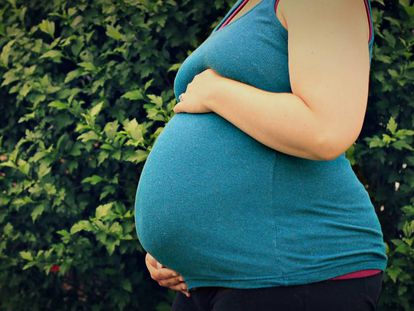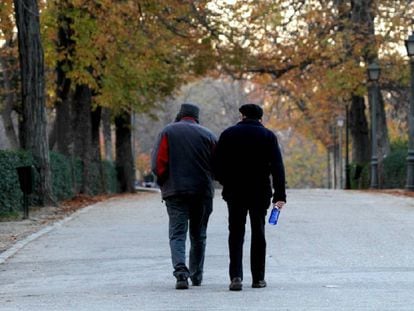Births in Spain fall to lowest level in 20 years, new figures reveal
The first six months of 2019 have set a new low as couples postpone parenthood due to precarious financial situations, among other factors


The number of babies born in Spain continues to fall to record lows. In 2018, there were 372,777 births, the lowest figure registered in the last two decades. That’s according to final data released on Wednesday by Spain’s National Statistics Institute (INE). This drop can also be seen in provisional results for the first six months of 2019: with 170,074 births from January to June, it is the lowest figure in a historical data series that began in 1941.
The fall is due to a decrease in population groups of childbearing age along with a drop in fertility. In 2018 women had an average of 1.26 children, the lowest figure since 2002. “The main thing to focus on is the growing gap between the number of desired children (around two) and the number of children that people actually have,” explains Albert Esteve, a demographer and director of Barcelona’s Center for Demographic Studies.
In 2018 women had an average of 1.26 children, the lowest figure since 2002
The data shows a population pyramid that narrows at the base and widens at the top. During the first six months of the year only three Spanish regions had more births than deaths (Madrid, Murcia and the Balearic Islands, as well as the exclave cities of Ceuta and Melilla). In this period births only increased in La Rioja, by 5.9%, while Melilla recorded the biggest decrease: 27.6%.
Last year was the fourth consecutive year where births fell across the country, and where Spain experienced a natural population decrease: in 2018 there were 54,944 more deaths than births. “This trend will continue in the next few years. We have large population groups that are aging, and even if they are living long and healthy lives, there are still more deaths,” says Esteve. Teresa Castro, a demographer for the Spanish National Research Council (CSIC) agreed with this: “It’s not a disaster. It’s been happening since the 1970s in Germany, where it’s compensated by migratory flows.” In Spain, in the first half of the year, 21.5% of newborns had a foreign-born mother, compared to 20.1% for the same period in 2018.
Between January and June of this year, 170,074 children were born in Spain, the lowest number since records began in 1941. Births have been declining in the first six months of the year for five consecutive years now. This year, the drop was 6.2% down from 2018.
Esteve insists that the natural decrease isn’t worrying. He emphasizes that what is important is that life expectancy has increased. Last year it went up by a tenth of a percentage point to 83.2 years of age.
It reflects the increasing difficulty for young people to carry out their reproductive plans Albert Esteve, demographer
The real problem lies in the drop in fertility rates, and in the gap between reproductive desires and reality. “It’s not bad so much because of this idea that children are needed to support the welfare state, but because it reflects the increasing difficulty for young people to carry out their reproductive plans, their desire to form a family,” says Esteve. “It’s unrealistic to think that we’re going to surpass the two children per woman average that we had in 1980.”
“We are among the European countries with the lowest fertility. The latest data from Eurostat, in 2017, shows that the average is 1.6 children per woman. But in France it is 1.9 and in Sweden it’s 1.8. There is a gap between the north and the south,” adds Teresa Castro. “It is due to two factors: a much more precarious labor market and fewer work-life balance policies. “I’m not saying that increasing paternity leave will automatically increase the birth rate. But there is evidence that measures such as free or affordable childcare facilities favor having children.”
Uncertainty
“We thought that fertility would go up again after the crisis, but it hasn’t. There are more jobs, but the precariousness is still there,” says Castro. “The data shows that something isn’t right, especially in the 30-to-40s age group. That’s the make-or-break period,” adds Esteve. “Having a child costs money. That money can come from state subsidies and social policies or from your own pocket. In the United States there is a powerful middle class that, despite lack of aid, can cover the costs. The Scandinavians also have good finances and good state support. In Spain there’s neither one nor the other,” he continues. “If we add to that the fact that women spend much more time parenting, the situation only gets worse," says the demographer.
“Regardless of the change in values, which leads people to want to develop other aspects of life such as studying, traveling and so on, which means they are not having children at the age of 20, if you look at the situation from the age of 30, you see that people have trouble securing a stable job or paying for housing,” explains Esteve. “Also, when it comes to having children, we have high standards that are difficult to meet. And if young people take longer to move out of the family home [at an average age of 29.5 in Spain, compared to 18.5 in Sweden, according to Eurostat] and move in with a partner, it means that children come much later,” says Esteve. In 2018, the average age to have a first child increased for the first time to over 31 years of age (31.02).
More young adults do not want to have children. Some point out that it’s due to economic and job-related impediments Demographer Teresa Castro
“All our life transitions are delayed. Having the first child later means that the second one is also postponed, if it comes at all. And if you make the decision to have a child late in life, you can also have fertility problems,” Castro says. “Nearly one-third of births are to women 35 and older.”
“Society today is different from what it was a few decades ago. More young adults do not want to have children. But among those who are not planning to have them, there are those who point out that it’s due to economic and job-related impediments,” adds Castro. “The obstacles are very significant.”
Castro believes that’s where there is room for improvement, but Esteve is skeptical. “Births may rise in a few years, partly linked to the increase in the population of childbearing age. I’m more pessimistic about fertility,” he explains. “If I had a magic wand and all women who wanted to have children could do so, we would be talking about 1.5 or 1.6 children per woman. But for that to happen, job and emancipation expectations must be improved.”
Nearly half of children are born to unmarried women in Spain
In Spain, 47.2% of children born in 2018 had a mother who wasn't married, according to data from INE. "This brings us in line with the European average, although there are countries such as France or Sweden where the figure is much higher," explains Teresa Castro, a demographer for the Spanish Scientific Research Council (CSIC). "I'm not saying that there has been an unusual increase in the number of single mothers, but above all, in the number of unmarried couples living together," she adds. "It's a very important social change compared to 30 years ago."
Provisional data from the first half of 2019 shows this fall in the number of marriages. In this period there were 71,980 marriages, 1.2% less than in the same interval in 2018. Broken down into regions, the greatest decreases were registered in Cantabria (13%), Murcia (8.3%) and in La Rioja (8.1%). The largest increases were seen in Galicia (18.1%), Ceuta (12.7%) and the Balearic Islands (2.7%).
English version by Alicia Kember.












































